 Millennials are an exacting crowd. Image source: Talkwalker
Millennials are an exacting crowd. Image source: Talkwalker
By Todd Grossman J. C. Penney, Macy’s – shutters down for several stores. In the last decade, Sears has closed 22 percent of its stores. The knock-on effect? The death of the mall – they are bleeding out. Those that ignored data analytics – did not invest in customer intelligence – are feeling the squeeze. Canny retailers saw this oncoming storm and, jumping onboard, brought about a phenomenal growth in ecommerce. Retail is bleeding out Last year, eMarketer wrote, “Retail ecommerce sales will reach $1.915 trillion in 2016 … The digital portion of sales continues to expand rapidly, with a 23.7 percent growth rate forecast for 2016.” Millennials’ buying power will soon surpass that of the generations before them. Having grown up in a mobile world, millennials expect to be able to run their lives from their phone. Chat to their friends on social media, buy clothes, tickets and books, search for answers, and make payments. Obviously, online shopping is a given but, it has to be wow. They want an enhanced experience, relevant recommendations, an easy and safe payment method, same-day delivery. Blinkered, traditional retailers suffered a huge blow as purchasing behavior changed. And, do not think that because your brand does not offer online shopping you are safe – 81 percent of shoppers research online before purchasing. Consumers are checking out product reviews – your brand is in competition. I presume you have an online presence? Role of social networks for retail A study from Accenture reveals that two-thirds of Generation Z shoppers are interested in purchasing via social media directly. Forty-four percent cite social media as a popular source for product inspiration. Thirty-seven percent have increased their use of social media for purchase decision-making in the last year. To survive, the traditional retail industry must tap into this group and learn. Go to where millennials and Generation Z are talking, and listen. Learn this new language. Where to start Retailers must prioritize mobile, personalization, customer service and a great customer service (CX) as their top digital business initiatives this year. They have to realize a new future. Consumers are busier, we want things faster, now. Even us Brits have had enough of queuing - a recent study showing that United Kingdom consumers are no longer willing to wait in line for more than six minutes. Six minutes – time was we would queue for a good three hours before getting antsy. Too much? Let us take a breath for a moment and start listening. A social listening platform hears what is being said online and on social media. The analytics revealed will identify customer behavior, opinion, sentiment and all that is being said about your brand – good and bad. Magic words: CX and trends Retailers who are already making the most out of social excel in two areas: customer experience and trends. Let us look at some examples of how they are shaping the future of shopping on social. Do not be afraid to follow trends. Starbucks sells coffee, just coffee. Not the best in the world, not the worst. Consumers buy into the experience. Whether it is designing their own cup, having their name misspelled on their latte and sharing on social media – intentional? Bloody clever if it is – or using the applications developed by the stores which make it easier to pay for their drink whilst earning points for discounts and freebies, they are buying into the experience. It is still just coffee in a cardboard cup – but it is Starbucks coffee in a cardboard cup.
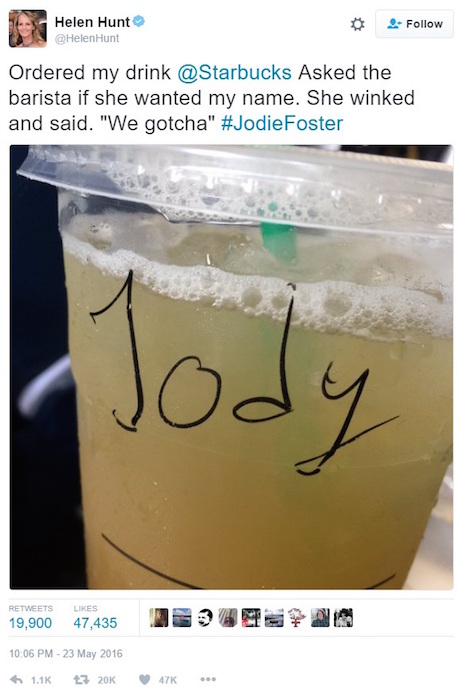 Name shame at Starbucks
Name shame at Starbucks
 Not just a purple unicorn
Not just a purple unicorn
 Unicorn Frapppuccino
Unicorn Frapppuccino
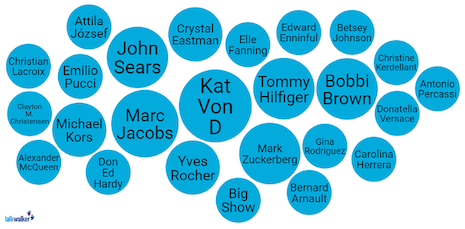 What is trending?
What is trending?
- In 2016, H&M introduced its bot – using Kik messaging application – as an extension to its brand that customizes the consumer’s shopping experience. Looking for inspiration, had enough of the darkness of Goth and considering the retro band T-shirts of hipsters - the H&M bot acts as personal stylist, answering questions and offering advice.
- Taco Bell jumped on the botwagon with TacoBot, using the Slack messaging platform. The bot – still in private beta mode – with a “sharp and witty personality,” chats, answers questions, and helps with food orders.
- In 2015, Domino’s pizza introduced “tweet to order.” In an effort to grab a larger slice of tech-savvy consumers, Domino’s CEO Patrick Doyle said, “We’ve got this down to a five-second exchange.” Frequent customers – suffering finger fatigue – barely have to type, simply tweeting a pizza emoji at the brand.
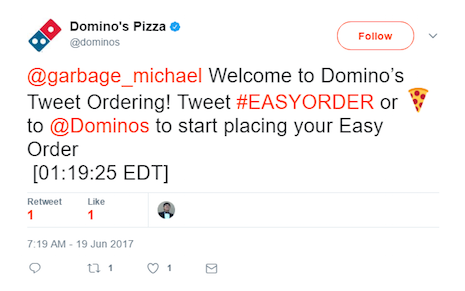 Domino's Easy Order tweet
Domino's Easy Order tweet
- Yep, Domino’s gets two bullet points – and well deserved. The pizza parlor – or should that be tech parlor – launched its Facebook Messenger chatbot at the end of 2016. Keeping it simple, you simply type “PIZZA”, and guess what … At the beginning of 2017, the bot called Dom, was updated. No longer necessary to create a Domino’s profile, cheese fans can access the whole menu directly from Messenger, and then track your order. This embracing of tech has given the firm an estimated $4.7 billion annually in global digital sales.
- Tommy Hilfiger was the first fashion brand to get with the bot trend. It launched its chatbot on Facebook Messenger to tie in with New York Fashion Week, named TMY.GRL. It provides a personalized and scalable shopping experience through the new collection using artificial intelligence. The brand uses various bots for different lines, including Tommy Girl and Tommy Pier.
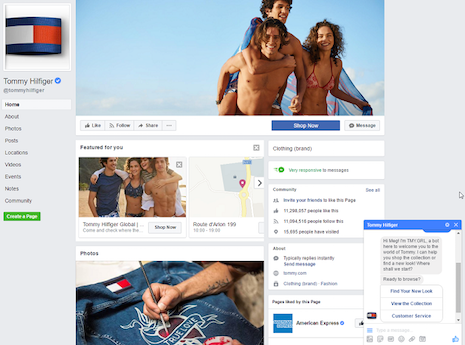 Tommy Hilfiger: Bot's up
Tommy Hilfiger: Bot's up
- Burberry’s Facebook Messenger chatbot – see-now-buy-now – is more interactive than most, engaging with customers and driving sales. The Burberry bot lets users watch a fashion show and talks about the new collection. Fans are invited to complete a maze, resulting in access being granted to an exclusive Burberry show space, where they can purchase from the latest line when they become available. Users are also given the option to talk with a human, if desired. Chavtastic.
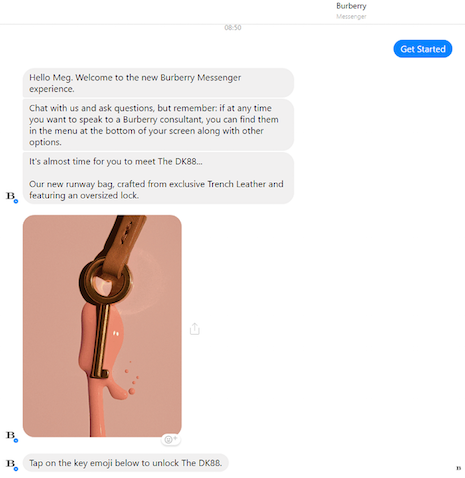 Burberry's got a lock on the bot
Burberry's got a lock on the bot
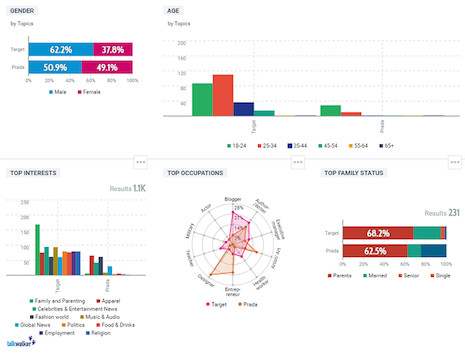 Target versus Prada - customer demographic
Target versus Prada - customer demographic
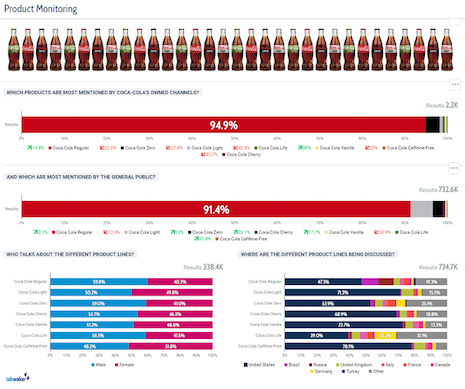 Monitoring the range of products reveals consumers’ preferences, gender breakdown and location of discussions
Monitoring the range of products reveals consumers’ preferences, gender breakdown and location of discussions
- Eighty-six percent of consumers say loyalty is driven by likability and 83 percent of consumers say trust. For example, in a fair swap for the customer's data, Sephora's Color IQ app provides value to customers by matching makeup with skin tone and personalizing the customer's shopping experience. The brand is happy, the customers are happy and wearing the correct moisturizer tone.
- H&M says, “Say goodbye to plastic membership cards. It’s all happening in your smartphone!” The brand launched its loyalty scheme in which shoppers earn points when purchasing in-store and online. Earned points unlock exclusive offers, promos, rewards and access to events. Users also get a 25 percent discount on their birthday, and 20 percent discount when you sign up online.
 Demonstrating the range of emotions over a set time period
Demonstrating the range of emotions over a set time period
- Customer centric. Ask yourself: are you in the business of helping your customers buy your products, or are you just going for the hard sell? Consumer connectivity and immersive interaction: retailers have to get to know consumers so that they are able to deliver a personalized experience. Know who you are talking to, understand how often they shop. Then you will be fully equipped to target with relevant offers, promotions, product alerts and shop openings to help.
- CX focused. What little touches in your store are talking to your customers, demonstrating what you think of them and making them feel special? Your customer experience has to be remarkable. Create a wow factor that will put your competitors to shame.
 Todd Grossman is CEO for North America at Talkwalker
Todd Grossman is CEO for North America at Talkwalker
